Oil Spill Response
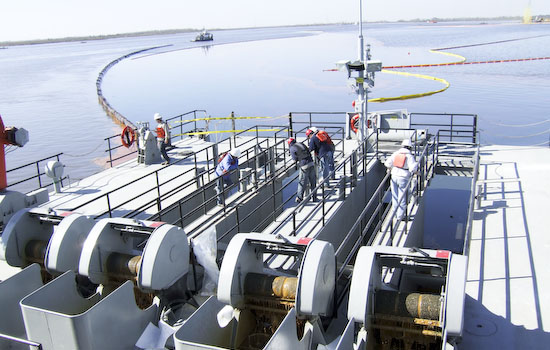
As Louisiana’s lead office for oil spill response, the Louisiana Oil Spill Coordinator’s Office (LOSCO) coordinates the state agencies that are involved in response and cleanup. The Oil Pollution Act of 1990 (OPA), 33 USC 2701 et seq. and the Louisiana Oil Spill Prevention and Response Act of 1991 (OSPRA), La. Rev. Stat. 30:2451 et seq. are the principal federal and state statues, respectively, which authorize federal and state agencies to provide for a coordinated response effort in the event of an unauthorized or threatened discharge of oil. LOSCO responds quickly and efficiently to any oil spill emergencies statewide. A LOSCO staff member is on call 24-hours a day, ready to respond as the State On-Scene Coordinator (SOSC), should the need arise. In addition to a quick response during spills, LOSCO has made advance preparation a priority.
To search and view available LOSCO response records, visit data.losco.org.
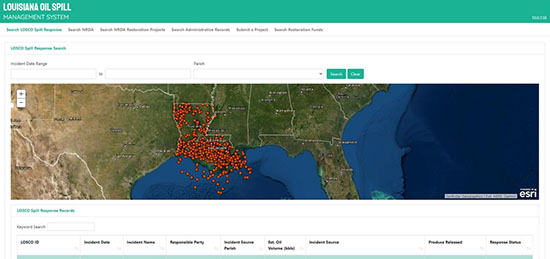
Notifications
For information on spill notifications in Louisiana reported to the National Response Center (NRC) you can search the NRC database.
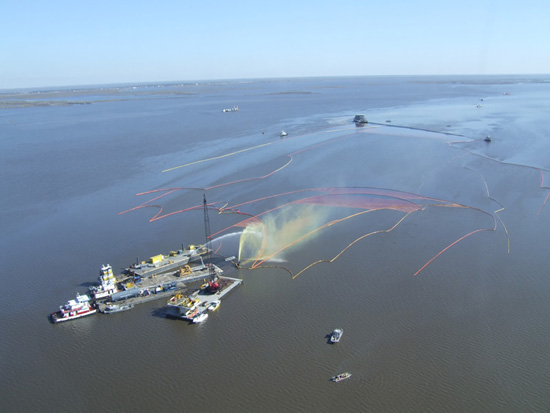
National Response System
The National Response System (NRS) is the government's mechanism for emergency response to discharges of oil and hazardous substances into navigable waters or environments of the United States and its territories. The NRS functions through a network of interagency and inter-government relationships which were formally established and are described in the Oil and Hazardous Substances Pollution Contingency Plan (NCP).
For more information on the NRS, click here
Regional Response Teams
Regional Response Teams (RRT) are a part of the National Response System. The RRT provides the mechanism for regional development and coordination of preparedness activities before a response action is taken, and for coordination of assistance and advice to the On-Scene Coordinators during such response actions. The RRT provides guidance to Area Committees, as appropriate, to ensure inter-area consistency and consistency of individual Area Contingency Plans (ACP). Every region in the United States has its own RRT charged with planning for and responding to emergency situations.
Louisiana is a member of the Region 6 RRT. Region 6 RRT membership consists of 15 federal agencies and five states with responsibilities, interests, and expertise in various aspects of emergency response to pollution incidents.
As a member of the Region 6 RRT, LOSCO plays a major role in shaping oil spill response policy. For example, LOSCO is working with RRT members to make a full range of alternative response technologies more easily available for field operations.
The following are Pre-Approval, Expedited-Approval, and Guidance Documents for RRT Region 6:
In-Situ Burns
Dispersants
Bioremediation Applications
Special Monitoring of Applied Response Technologies (SMART) is the cooperatively designed monitoring protocol for use during in-situ burn and dispersant applications.
The State of Louisiana also has additional guidelines that outline the monitoring requirements for in situ burns of on-shore oil spills.
For more information on RRT, click here.
For more information on the Region 6 RRT, click here.
Government Oil Spill Contingency Plans
To ensure a quick and efficient response to an oil spill, responders must know what steps to take in the event of an emergency. Contingency plans describe information and processes for containing and cleaning up an oil spill that occurs in a defined geographic area. The following is a description of national, area, and state contingency plans, as they pertain to Louisiana, and as mandated by the Oil Pollution Act of 1990 (OPA) and the Oil Spill Prevention and Response Act of 1991 (OSPRA).

National Oil and Hazardous Substances Pollution Contingency Plan
The National Oil and Hazardous Substances Pollution Contingency Plan (NCP) is the government’s blueprint for responding to oil or hazardous substance releases that are beyond the capabilities of local and state responders. The NCP was developed to provide for national response capabilities and to promote overall coordination among the hierarchy of responders and contingency planners. The NCP provides the framework for the National Response System and establishes how it works.
For more information on the NCP, click here.
Area Contingency Plans and Geographic Response Plans
The Oil Pollution Act of 1990 mandated the creation of Area Contingency Plans (ACP). The plans describe response strategies for targeted areas, thereby providing an essential layer of preparation for oil spills. A committee guides each plan's development and revisions. The committees are composed of representatives from industry, environmental groups, and planners from federal, state, and local government. The committees meet regularly to update oil spill response plans, identify sensitive resources, and develop site-specific response strategies. In Louisiana, the committees are co-chaired by LOSCO and the USCG.
A Geographic Response Plan (GRP) is a planning document and response tool that is intended to guide local responders in the first 24-48 hours of an oil spill until additional resources supplied by Unified Command can arrive. As a response tool, the GRP allows quick decisions to be made by providing detailed geographic information on shoreline types, sensitive natural and cultural resources. A GRP is usually part of the ACP that each USCG Sector is required to maintain to enhance preparedness and prevention activities for all coastal areas of the United States.
Links to the 3 coastal Louisiana ACPs and available associated GRPs are provided below:
Inland areas are also at risk from oil spills. The planning needs of these areas are covered by the Region 6 Regional Integrated Contingency Plan.
The State Contingency Plan
Federal, state, and local agencies all play a role in oil spill response – a situation that demands clear lines of communication and command. In 1995, LOSCO and its partners in state government created a plan that describes how Louisiana agencies will respond during oil spills. Called the State Contingency Plan, this document helps clarify and streamline response procedures. State agencies involved in the plan include:
Response Plans for Acts of Terrorism and Natural Disasters
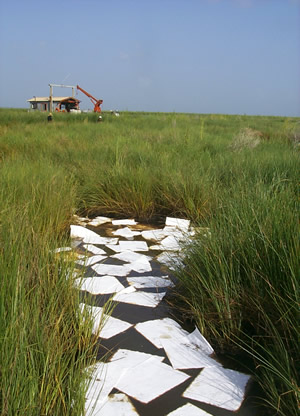 |
Acts of terrorism and natural disasters can result in large oil spills that are emergencies requiring quick and effective action. During such events, federal and state agencies operate using the National Response Framework, in accordance with the Robert T. Stafford Disaster Relief and Emergency Assistance Act (PL 100-707); and in Louisiana, the Louisiana Emergency Operations Plan, in accordance with the Louisiana Homeland Security and Emergency Assistance and Disaster Act 1993, La. Rev. Stat. 29:721 et seq.
|
National Response Framework
The National Response Framework establishes a comprehensive all-hazards plan for responding to Incidents of National Significance. The National Response Framework is the core plan for managing domestic incidents and details how the federal government coordinates with state, local, tribal government, and the private sector, during such incidents. The National Contingency Plan is linked to the National Response Framework, but remains as a subordinate stand alone plan for responding to spills that do not require Department of Homeland Security coordination.
For more information on the National Response Framework, click here.
Louisiana Emergency Operations Plan
Like the National Response Framework, The Louisiana Emergency Operations Plan (EOP) establishes the policies and structure for State government management of emergencies and disasters. The EOP prescribes the phases of emergencies and disasters; prevention, mitigation, preparedness, response and recovery. The EOP is an all-hazard plan. It assigns responsibilities for actions and tasks that the State will take to provide for the safety and welfare of its citizens against the threat of natural, technological, and national security emergencies and disasters. The EOP is designed to coordinate closely with the National Response Framework and with Parish Emergency Operations Plans. The Governor’s Office of Homeland Security and Emergency Preparedness has the responsibility for formulating and updating the State of Louisiana’s emergency operations plan, procedures, arrangements and agreements, and for coordinating emergency operations under the direction of the Governor.
The Louisiana Oil Spill Coordinator is responsible for the conduct of response and recovery to oil spills under emergency function ESF10 of the EOP.
For more information on the Governor’s Office of Homeland Security and Emergency Preparedness (GOHSEP, click here.
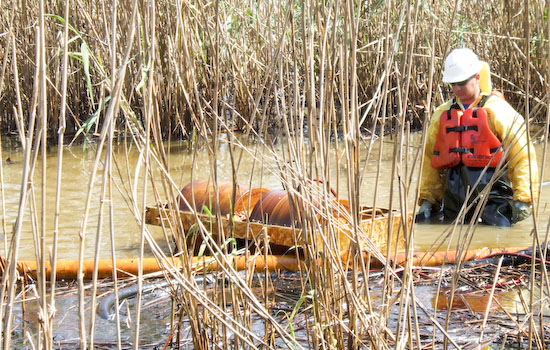
Vessel and Facility Response Plans
State and federal agencies are not the only entities that develop oil spill contingency plans. Oil companies are required to create and update Vessel Response Plans (VRPs) for tank vessels and certain non-tank vessels; as well as Facility Response Plans (FRPs) for offshore facilities, onshore facilities, and pipelines. All VRPs and FRPs must be consistent with the National Contingency Plan and applicable Area Contingency Plans; and FRPs should be coordinated with local emergency response plans. VRPs and FRPs identify the response organization, emergency response procedures, and strategies for responding to a discharge up to a worst case discharge. For VRPs, salvage, lightering, and shipboard firefighting resources must also be identified. You may now email VRPs and FRPs to LOSCO@la.gov
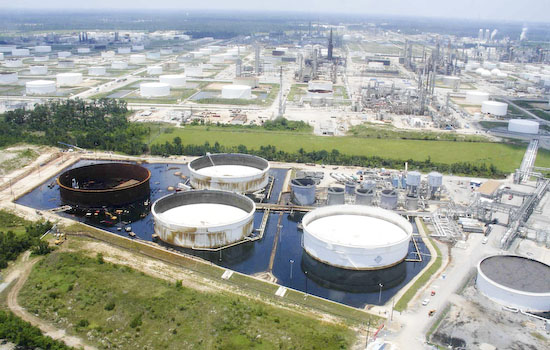
Oil Spill Response Drills
The drills encompass the entire response process, from spill notification to deployment of equipment and personnel. LOSCO regularly participates in drills, some of which are conducted as table top exercises, and some of which require companies to send employees and equipment into the field. The drills give all parties involved the opportunity to fine tune procedures, test response times, and forge good working relationships with partners who can assist them if a spill occurs. Please email LOSCO@la.gov if you would like LOSCO to be a part of your next oil spill response drill.
Partnering with Federal Agencies
LOSCO works closely with federal agencies during oil spill events. LOSCO, as the SOSC, coordinates with the Federal On-Scene Coordinator (FOSC) to monitor or direct responses to oil spills reported to the federal government.
In the coastal zone, the FOSC is one of the following, depending on the location of the spill:
- USCG/MSO New Orleans
- USCG/MSO Morgan City
- USCG/MSO Port Arthur
The US EPA is the FOSC for the inland zone of Louisiana.
Response Tools
A number of useful tools are available to assist contingency planners and oil spill responders.
The Environmental Data Gateway (EDG) identifies and catalogues a variety of information and technical data potentially useful in oil spill prevention, planning and response initiatives throughout inland and coastal Louisiana. The EDG is designed to provide quick access to open tabular and geospatial data sets, web based applications, and websites to oil spill response and natural resource/environmental management practitioners. Visit data.losco.org and click on “Environmental Data Gateway” or click the link below to begin using the EDG.


|